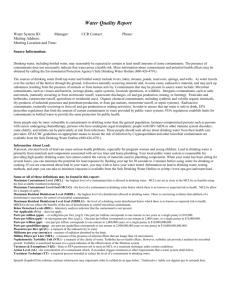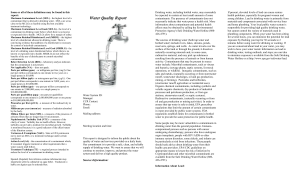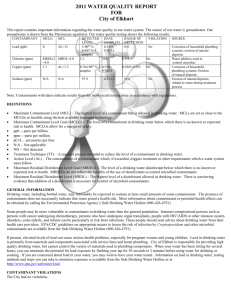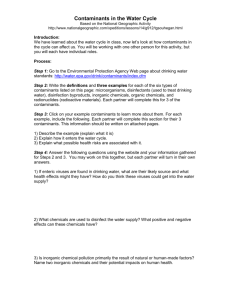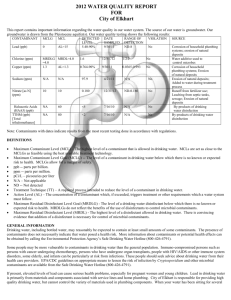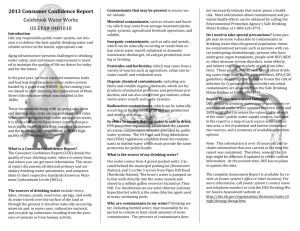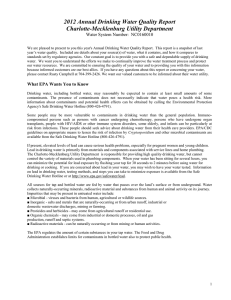CCR Brochure Template (version 2)
advertisement
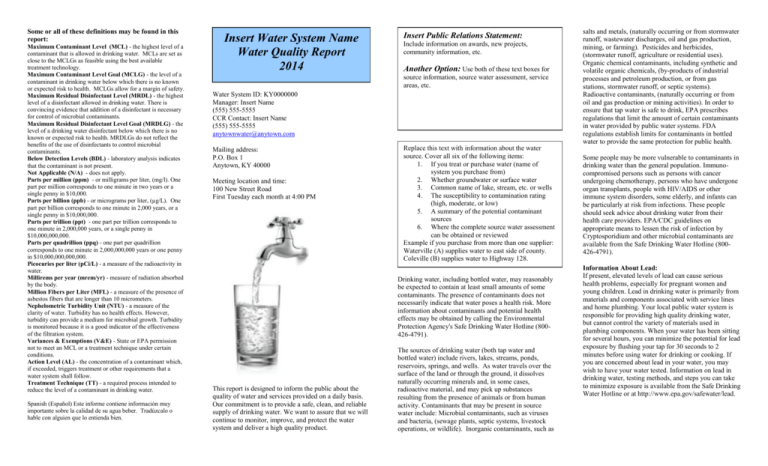
Some or all of these definitions may be found in this report: Maximum Contaminant Level (MCL) - the highest level of a contaminant that is allowed in drinking water. MCLs are set as close to the MCLGs as feasible using the best available treatment technology. Maximum Contaminant Level Goal (MCLG) - the level of a contaminant in drinking water below which there is no known or expected risk to health. MCLGs allow for a margin of safety. Maximum Residual Disinfectant Level (MRDL) - the highest level of a disinfectant allowed in drinking water. There is convincing evidence that addition of a disinfectant is necessary for control of microbial contaminants. Maximum Residual Disinfectant Level Goal (MRDLG) - the level of a drinking water disinfectant below which there is no known or expected risk to health. MRDLGs do not reflect the benefits of the use of disinfectants to control microbial contaminants. Below Detection Levels (BDL) - laboratory analysis indicates that the contaminant is not present. Not Applicable (N/A) - does not apply. Parts per million (ppm) - or milligrams per liter, (mg/l). One part per million corresponds to one minute in two years or a single penny in $10,000. Parts per billion (ppb) - or micrograms per liter, (µg/L). One part per billion corresponds to one minute in 2,000 years, or a single penny in $10,000,000. Parts per trillion (ppt) - one part per trillion corresponds to one minute in 2,000,000 years, or a single penny in $10,000,000,000. Parts per quadrillion (ppq) - one part per quadrillion corresponds to one minute in 2,000,000,000 years or one penny in $10,000,000,000,000. Picocuries per liter (pCi/L) - a measure of the radioactivity in water. Millirems per year (mrem/yr) - measure of radiation absorbed by the body. Million Fibers per Liter (MFL) - a measure of the presence of asbestos fibers that are longer than 10 micrometers. Nephelometric Turbidity Unit (NTU) - a measure of the clarity of water. Turbidity has no health effects. However, turbidity can provide a medium for microbial growth. Turbidity is monitored because it is a good indicator of the effectiveness of the filtration system. Variances & Exemptions (V&E) - State or EPA permission not to meet an MCL or a treatment technique under certain conditions. Action Level (AL) - the concentration of a contaminant which, if exceeded, triggers treatment or other requirements that a water system shall follow. Treatment Technique (TT) - a required process intended to reduce the level of a contaminant in drinking water. Spanish (Español) Este informe contiene información muy importante sobre la calidad de su agua beber. Tradúzcalo o hable con alguien que lo entienda bien. Insert Water System Name Water Quality Report 2014 Insert Public Relations Statement: Include information on awards, new projects, community information, etc. Another Option: Use both of these text boxes for source information, source water assessment, service areas, etc. Water System ID: KY0000000 Manager: Insert Name (555) 555-5555 CCR Contact: Insert Name (555) 555-5555 anytownwater@anytown.com Mailing address: P.O. Box 1 Anytown, KY 40000 Meeting location and time: 100 New Street Road First Tuesday each month at 4:00 PM Replace this text with information about the water source. Cover all six of the following items: 1. If you treat or purchase water (name of system you purchase from) 2. Whether groundwater or surface water 3. Common name of lake, stream, etc. or wells 4. The susceptibility to contamination rating (high, moderate, or low) 5. A summary of the potential contaminant sources 6. Where the complete source water assessment can be obtained or reviewed Example if you purchase from more than one supplier: Waterville (A) supplies water to east side of county. Coleville (B) supplies water to Highway 128. Drinking water, including bottled water, may reasonably be expected to contain at least small amounts of some contaminants. The presence of contaminants does not necessarily indicate that water poses a health risk. More information about contaminants and potential health effects may be obtained by calling the Environmental Protection Agency's Safe Drinking Water Hotline (800426-4791). This report is designed to inform the public about the quality of water and services provided on a daily basis. Our commitment is to provide a safe, clean, and reliable supply of drinking water. We want to assure that we will continue to monitor, improve, and protect the water system and deliver a high quality product. The sources of drinking water (both tap water and bottled water) include rivers, lakes, streams, ponds, reservoirs, springs, and wells. As water travels over the surface of the land or through the ground, it dissolves naturally occurring minerals and, in some cases, radioactive material, and may pick up substances resulting from the presence of animals or from human activity. Contaminants that may be present in source water include: Microbial contaminants, such as viruses and bacteria, (sewage plants, septic systems, livestock operations, or wildlife). Inorganic contaminants, such as salts and metals, (naturally occurring or from stormwater runoff, wastewater discharges, oil and gas production, mining, or farming). Pesticides and herbicides, (stormwater runoff, agriculture or residential uses). Organic chemical contaminants, including synthetic and volatile organic chemicals, (by-products of industrial processes and petroleum production, or from gas stations, stormwater runoff, or septic systems). Radioactive contaminants, (naturally occurring or from oil and gas production or mining activities). In order to ensure that tap water is safe to drink, EPA prescribes regulations that limit the amount of certain contaminants in water provided by public water systems. FDA regulations establish limits for contaminants in bottled water to provide the same protection for public health. Some people may be more vulnerable to contaminants in drinking water than the general population. Immunocompromised persons such as persons with cancer undergoing chemotherapy, persons who have undergone organ transplants, people with HIV/AIDS or other immune system disorders, some elderly, and infants can be particularly at risk from infections. These people should seek advice about drinking water from their health care providers. EPA/CDC guidelines on appropriate means to lessen the risk of infection by Cryptosporidium and other microbial contaminants are available from the Safe Drinking Water Hotline (800426-4791). Information About Lead: If present, elevated levels of lead can cause serious health problems, especially for pregnant women and young children. Lead in drinking water is primarily from materials and components associated with service lines and home plumbing. Your local public water system is responsible for providing high quality drinking water, but cannot control the variety of materials used in plumbing components. When your water has been sitting for several hours, you can minimize the potential for lead exposure by flushing your tap for 30 seconds to 2 minutes before using water for drinking or cooking. If you are concerned about lead in your water, you may wish to have your water tested. Information on lead in drinking water, testing methods, and steps you can take to minimize exposure is available from the Safe Drinking Water Hotline or at http://www.epa.gov/safewater/lead.
